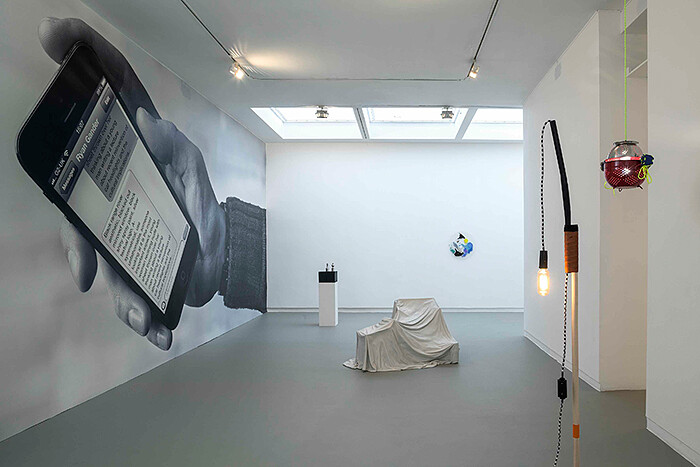Black-and-white photo wallpaper depicting a gargantuan hand holding an iPhone with two text message bubbles visually dominates Ryan Gander’s show at Annet Gelink in Amsterdam. With the imperative title Be Prepared (2013) the stage is set for potential. I learn that the text displayed on the phone describes a probable artwork the artist thought of making while at a party. The first message reads like an absurdist title to an overtly simple sculpture, which looks like a person wearing a bed sheet over their head: “sheet thrown over her thinking about a young man writing a lecture about recent reinvention of car headlights and the cultural implications…” While the second message builds, like an exquisite corpse, on the visual details not of the artwork itself, but of the setting and (“importantly,” the artist tells us) of the viewer: “Black range rover aesthetic, blacked out mirrored window, black shiny spray paint, silver textual logo, A–Symmetrical, use unfathomable, someone looking at it is the most important aspect, young woman reclining nude with sheet thrown over her thinking about a young man writing a lecture about recent reinvention of car headlights and the cultural implications…” Forget about her “reclining nude,” forget about her thoughts. She’s covered, after all, with a sheet!
When describing the art of Andy Warhol, art historian Benjamin Buchloh wrote that Warhol embodied the paradox of modernist art. But what is that exactly? According to Theodor W. Adorno, it’s if modernist art is “to have a history at all while under the spell of the eternal repetition of mass production.”1 Gander’s often mysterious works utilize reproducible technology, while history is made present through language. This dialectical tension resembles a peculiar pataphysical wisdom embedded in the cares of the everyday. The title of the show “Once upon a Bicycle, not so long ago,” for instance, refers as much to pataphysical imagery as to the familiar act of biking. But if pataphysics is the science of imaginary solutions and the laws governing exceptions, in Gander’s recent work the exceptions are also inexplicably and inevitably intertwined with the domestic, and the intersections of life and art.
Upon entering the exhibition, one encounters the first sculpture: it’s luggage, albeit fashioned of marble resin (My head on your Belly, 2013), a replica of the one checked bag and carry-on that accompany Gander on his trips away from his family. On the one hand, the work is a kind of nominalist readymade, a snapshot of the artist-on-the-go in a globalized world, but on the other, its title refers to a certain longing for staying put (as does its travel-unfriendly material). In a similar line of thought, Gander makes lamps for his wife by combining illogical components—a tennis racket grip, doorstops, a bicycle handlebar—with the necessary electrical cables and a light bulb. But Gander’s lamps do not “shed light” by directly addressing or illuminating the historical. The lamp is there, rather, to produce a warm human environment among the heaps of absurdities and insecurities life offers. The work I is…(iii) (2013), conceived after seeing a makeshift shelter constructed by his three-year-old daughter, consists of a sheet draped over two Rietveld Crate chairs (one normal size and the other designed for children), but this too has been fashioned in heavy marble. Not only does the material suggest, obviously, the opposite of lightness, but at first glance the sculpture’s “content” remains likewise inaccessible; the process of its making is both revealed and concealed, and only when one looks to the press release are the details made real. While the sculpture represents a child’s temporary tent, it is one the beholder cannot enter but only imagine.
Another work, Please be patient – Rebecca and Olive lying on the floor looking through the cracks in Cromer Pier, Norkolk, Midday, 28 August, 2012 (2013), refers to the private archives of the artist. It is part of an unlimited series of portraits of individuals Gander has met during his life, and then paints from memory. While the actual portraits remain concealed from the public eye (Gander never exhibits them, at least, and who knows if they even exist?), the viewer is presented instead with a glass disk marred with irregular heaps of color, which had been purportedly used as a palette in the process of the portrait making.
But even when the works are visible, they’re easy to miss. Songs for nostalgic Imagineering (2013), for example, is a miniscule, indeed, hardly perceptible 3.5 mm hole in the white wall holding an audio jack enabling visitors to plug in their own pair of headphones and listen to a playlist of 103 tracks compiled by the artist. But you have to be a detective seeking out the crime against the minimalism of white walls to find the jack. And then there’s the matter of if you happen to have headphones on hand. Its experience makes for something ruled by destiny and chance.
In this limbo zone between hidden origins and bespoken potential, the artworks reign with a child’s inexplicable wisdom. Between being and not being, between the idea and its materialization, Gander questions the role of both the artist and the artwork by a series of detours—and, certainly, an abundant presence of absence. The bicycle—or “that which rolls” as it was famously called by the father of pataphysics Alfred Jarry—is not present in the exhibition. Yet, in Amsterdam, where everyone bikes, “once upon a time” and beyond, “not so long ago” and tomorrow afternoon, the bicycle becomes a placeholder for the kind of clumsy, enigmatic driving force of artistic creation.
Benjamin H. D. Buchloh, “Andy Warhol’s One Dimensional Art: 1956 –1966,” in Annette Michelson (ed.), Andy Warhol (Cambridge, MA & London: MIT Press, 2001), pp. 1–2.








